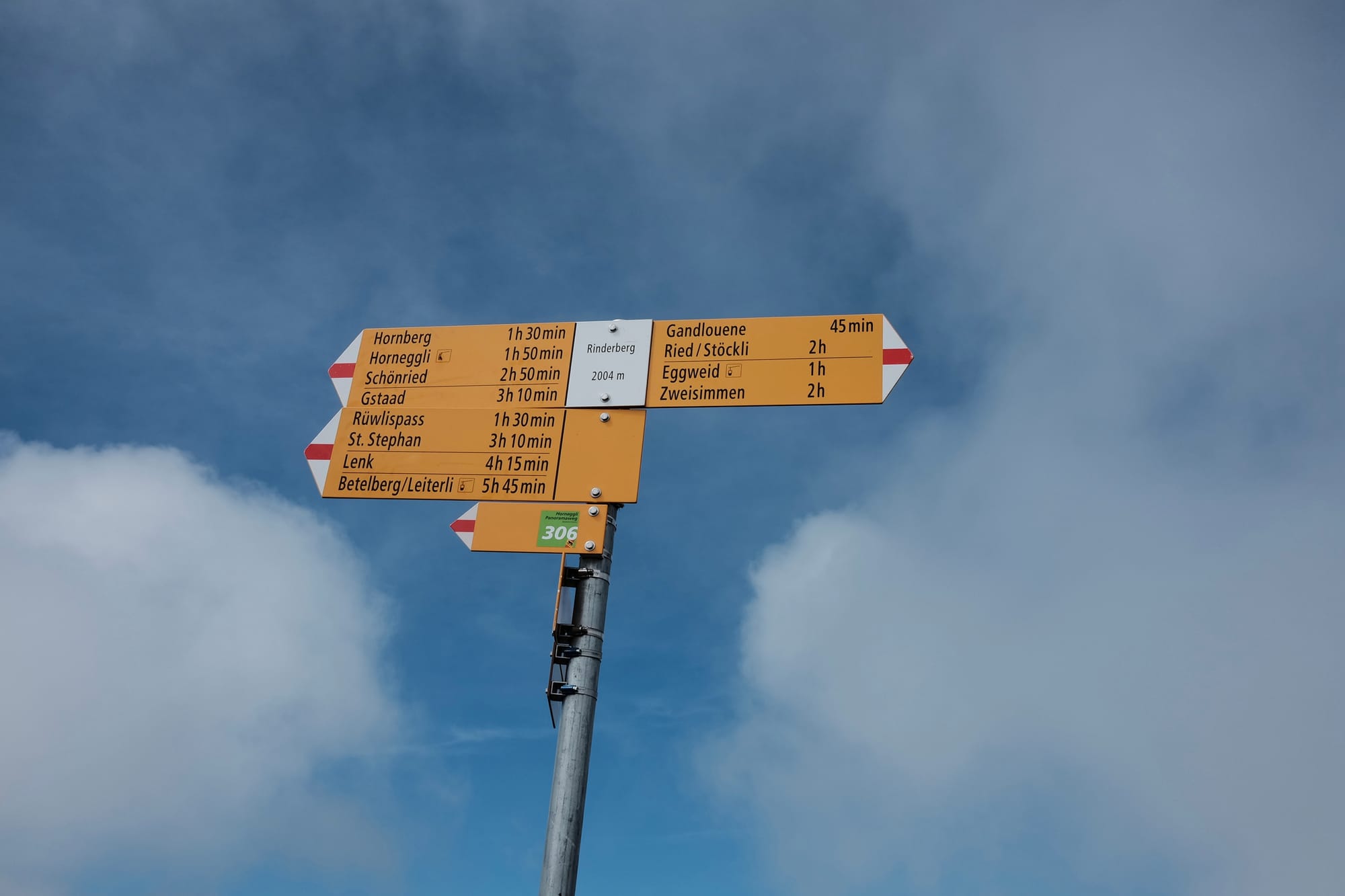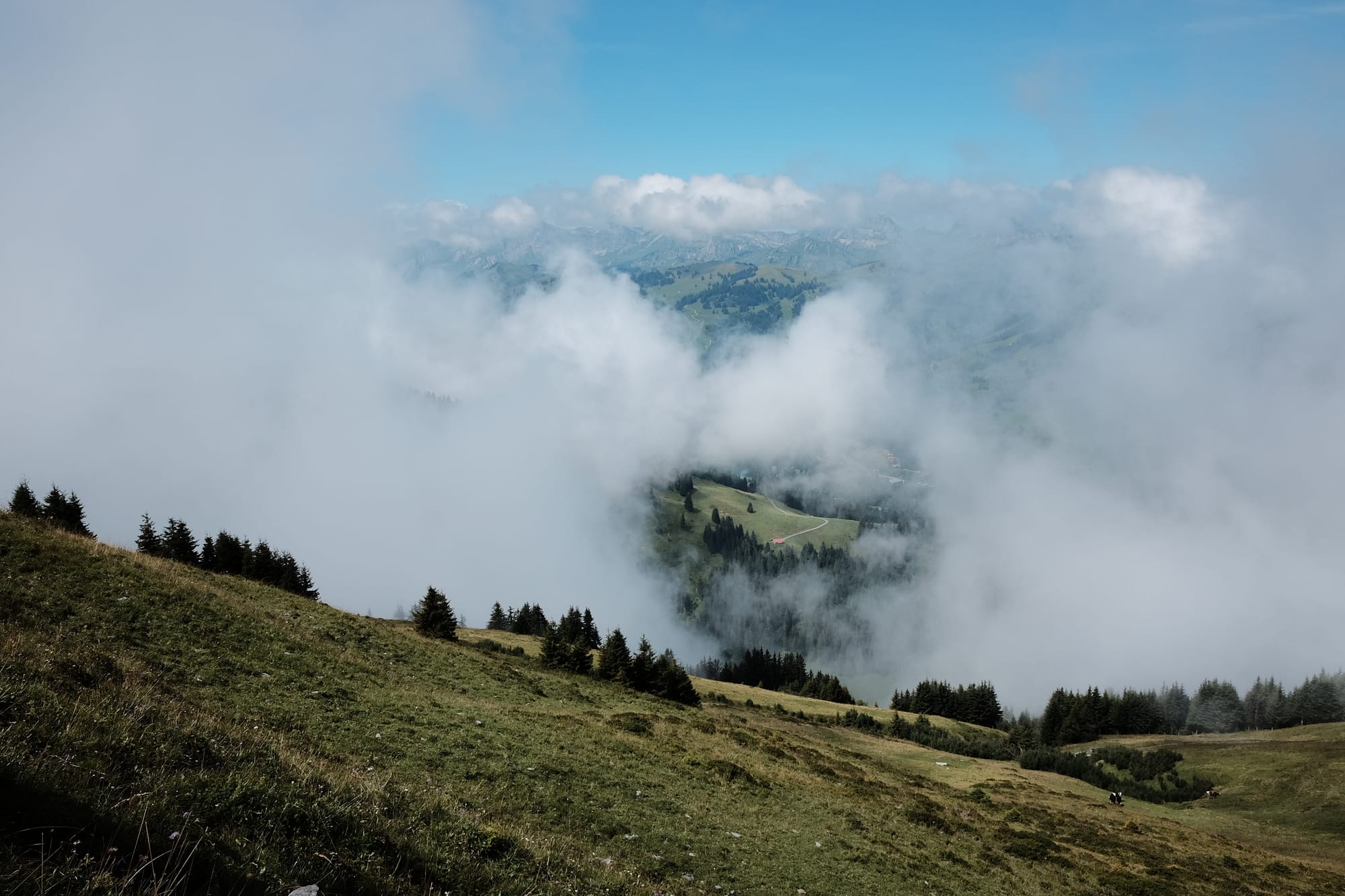Patience and the panorama
We awoke to see low cloud shrouding the mountain. There was nothing to do but sit and wait, refreshing the summit webcam and the weather app.

Our immediate future was in the hands of the Swiss Federal Office for Meteorology and Climatology. Would the forecasters’ prediction of an end to the heavy rain, a lifting of the cloud, prove correct? There were some promising signs but the view on the Rinderberg webcam remained stubbornly blank with cloud wrapping the summit.
We paced around the apartment, packed and repacked our lunch, tried to read our books. But it was never long before one of us reached for a phone to refresh the webcam page and check on progress. What would we do if the cloud didn’t lift? This was our final day in the mountains and our last chance to walk the Rinderberg-Horneggli route before our Interrail journey moved on.
“An amazing panorama of both the Simmental and Saanenland unfolds before your eyes,” promised the description on the SwitzerlandMobility site. The route is number 306 in an amazing network of trails for hiking, cycling, skating, canoeing, snowshoe trekking, cross-country skiing and sledging that stretch across Switzerland and Lichtenstein.
These trails are impeccably well organised: single-digit numbers for national routes, double digits for regional routes and triple digits for local routes. They’re well signed on the ground, and the website – with its accompanying app – makes route planning easy. Perfect for a family walk.

All we needed now was the cloud to clear. Another refresh of the webcam. Still nothing. Another refresh. Was that something? There, a shape in the image as the camera panned? Yes, a cable car tower was just visible through the cloud. Then another. A few more minutes and we were certain that visibility was improving. It was time to go.
We repacked our bags for the final time and set off on the short walk to the base station in the centre of Zweisimmen. The cable car would take us to the top of the Rinderberg, from where we’d walk the ridge line to Horneggli before catching the chairlift down to Schönried and a short train ride back to Zweisimmen.
It would be an easy, largely downhill walk. After purchasing tickets from a patient lady at the base station, we hopped into a gondola. The cable grabbed hold and we accelerated out of the building before settling into a steady pace in the open air above the meadows. The intermediate station at Eggweid came and went. The slope below us grew steeper. And then the summit arrived, patches of blue sky washing between white cloud.
Although the Rinderberg would loom large over Ben Nevis, at 2,079m it’s considerably shorter than nearby giants: the Eiger at 3,970m, and the Jungfrau at 4,158m. In awe of the scale, we hung around the cable car station for a while, eating our lunch and peering between the clouds to pick out different peaks. Then, when we’d had our fill, we set off for Horneggli.
We descended gradually, following the yellow marker signs along narrow ridges to reach the lush pasture of high meadows. Here the chilled air and eery sound of wind-whipped cables at the Rinderberg were replaced by warm sunshine and the comforting tinkle of cowbells. Winter ski infrastructure lay dormant, lifts awaiting the return of snow.

But in a changed climate, snowfall at these lower altitudes is not as reliable as it once was. Researchers at the University of Basel have found that resorts below 1,800-2,000m could have to abandon their lower slopes, with higher slopes reliant on artificial snowmaking – a process that’s energy and water intensive.
The impact on a winter tourism industry worth billions could be huge, and it threatens to be equally devastating for biodiversity. As glaciers recede, Alpine plants are migrating upwards as lowland plants displace them. Ultimately, many species could lose their habitat entirely and be forced into extinction.
It was a gloomy thought for what had become a bright sunny day. That, I guess, is the thing about the climate crisis. It can infect you with dark and hopeless despair, or it can make you treasure every interaction with an increasingly precious, and precarious, natural world.
We knew, as the chairlift swung us down the final stretch towards our rail connection, that we’d treasure our day in the mountains. It was a sunny reward for our patience.

